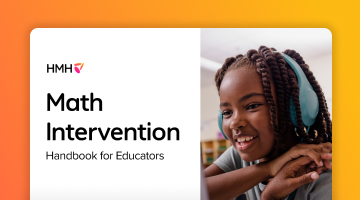
Writing is one of the most cognitively demanding tasks we ask students to do, but it’s also one of the most transformative skills they can develop. So, what is the science of writing? It’s a growing body of interdisciplinary research that explains how students learn to write and how educators can teach this complex skill effectively.
Just like the science of reading, the science of writing draws research findings in cognitive psychology, neuroscience, linguistics, and education. When integrated into instruction, these insights help students become confident, capable communicators across disciplines. This research applies across the K–12 spectrum, but instructional strategies and student needs vary significantly by grade level. Where appropriate, this article highlights distinctions between early elementary (K–5) and upper grade levels (6–12).
Here we will define the science of writing, explore how to integrate writing with reading instruction, and review evidence-based practices for teaching writing that support student success.
Science of writing definition
The science of writing refers to a research-based understanding of how students learn to write and how educators can teach it effectively. This field includes decades of research on writing acquisition, instruction, and the cognitive processes involved in creating written text.
A key model is the Simple View of Writing, developed by Berninger et al. (2002), which divides writing into two core components:
- Transcription: The physical act of writing, including spelling, handwriting, and typing.
- Composition: The generation, organization, and communication of ideas.
This model was later expanded into the Not-So-Simple View of Writing by Berninger & Winn (2006), which adds two critical dimensions: executive functions, such as planning, goal setting, reviewing, and self-regulation, and working memory, the ability to hold and manipulate information during the writing process. These additions reflect more recent findings from brain imaging and cognitive science, reinforcing that writing is a complex, multifaceted process.
Mastering both transcription and composition, through consistent, scaffolded practice paired with timely feedback, is essential for writing proficiency. Additionally, skills such as planning, revising, and evaluating—which fall under executive functions—should be explicitly taught. Research by experts like Dr. Steve Graham, the Warner Professor in the Division of Leadership and Innovation at Arizona State University Teachers College, shows that research-based writing instruction improves writing quality, motivation, and self-efficacy.
In How Does Writing Fit Into the Science of Reading?, Julie Richardson, Principal Designer of Literacy Content Solutions at HMH, emphasizes that writing is an essential component of literacy, not just a support for reading. She identifies six key elements of effective writing programs, such as frequent writing, peer collaboration, and integration with reading.
The relationship between reading and writing
Integrating reading and writing is effective because the relationship between reading and writing is reciprocal and essential. Reading instruction supports writing, and writing instruction supports reading. As Tim Shanahan says, “Reading and writing are two buckets drawing water from a common well.”
When students read, they encounter new vocabulary, grammar, and syntax. Writing gives them the opportunity to apply what they’ve learned. Both processes require comprehension, analysis, and expression. For example, when students write about what they read—whether summarizing, analyzing, or responding—they deepen their understanding of the material and improve fluency.
Renee Behring, Efficacy Research Director for Core ELA at HMH, notes in The Science of Reading Explained, how foundational reading skills like phonics and fluency are best learned through explicit instruction. The same principles apply to writing. When students encode sounds, organize ideas, and express meaning, they strengthen both reading and writing.
Research further reinforces this connection, showing that reading and writing are mutually supportive, with integrated instruction improving vocabulary, comprehension, and content knowledge. As educators, focusing on both the science of reading and writing is key to ensuring students develop the full range of literacy skills.
Evidence-based practices for teaching writing
The Not-So-Simple View of Writing identifies four interrelated components essential for writing development: transcription, text generation, executive functions, and working memory.
The strategies below can largely be adapted across K–12. While K–5 students may focus more on foundational transcription and encoding, older students (grades 6–12) benefit from deeper genre-based writing, strategic planning, and revision work.
1. Build transcription fluency
Develop automaticity in handwriting, spelling, and keyboarding to free cognitive resources for higher-level thinking.
- Incorporate handwriting exercises that reinforce sound-symbol relationships.
- Play spelling games and have students write sentences with decodable words to strengthen fluency.
- In grades 6–12, transcription fluency may shift toward typing speed, formatting, and using digital tools efficiently.
2. Strengthen text generation
Help students express ideas clearly and organize them into coherent sentences and paragraphs.
- Design writing tasks that focus on phonics patterns (e.g., silent-e, r-controlled vowels).
- Have students craft sentences using specific patterns to reinforce meaning and structure.
- For older students, focus on expanding sentence complexity, coherence across paragraphs, and academic language appropriate to the genre.
3. Develop executive functions
Teach students to plan, monitor, and revise their writing for clarity and quality.
- Use graphic organizers, checklists, and peer review protocols to scaffold planning and revising.
- Incorporate strategies like repeated readings followed by written reflections.
- Upper-grade students may also benefit from goal-setting rubrics and annotated exemplars to guide their revision process.
4. Support working memory
Reduce cognitive load and help students manage multiple writing demands.
- Use sentence combining, summarizing, and genre-specific scaffolds to support idea integration.
- Provide guided practice and timely feedback to help students internalize strategies.
- Establish structured routines to maintain coherence and reduce overload.
Guided practice and timely feedback in writing
Explicit writing instruction can be paired with opportunities for guided practice and corrective feedback. Students benefit from seeing strategies modeled, trying them out with support, and receiving targeted feedback during the writing process—not just after completion.
- Use think-alouds and shared writing to demonstrate key skills.
- Offer structured practice time with clear expectations.
- Provide immediate, actionable feedback during drafting and revision stages.
- Use conferences, rubrics, and exemplar texts to deepen understanding.
Whether in early grades or secondary classrooms, this combination of modeling, practice, and timely feedback helps students move from supported practice to independent, proficient writing.
Oral language as a foundation for writing
It’s also important to consider how much students rely on oral language as they grow as writers. Oral language development, which starts in infancy, forms the foundation for literacy.
As students develop verbal expression, they build the vocabulary, syntax, and grammar that support reading and writing. Encouraging storytelling, classroom discussions, and group talk enhances students’ writing clarity and purpose. For example, pairing writing assignments like persuasive essays or playwrighting with oral activities, like debates or podcasting, helps bridge the gap between speaking and writing, reinforcing both skills.
Writing and genre-specific standards alignment
Effective writing instruction includes genre-specific strategies to help students master narrative, informative, and argumentative writing. While instruction should align with grade-level standards, research shows that students may be ready for more complex writing tasks earlier than expected when given appropriate scaffolding. For example, a third-grade student might be ready to write a short research paper if given the right scaffolding, even if the standards suggest it’s a task for older students.
The role of AI in writing instruction
Teachers and students can both find support for genre-specific writing through new AI tools, especially when those tools are used effectively. For example, as AI tools become more integrated into classrooms, they can support writing instruction by offering feedback, generating prompts, and maintaining motivation.
However, human guidance remains essential for nurturing critical thinking and an authentic writing voice. Teachers can help students use AI responsibly, ensuring it complements their creativity rather than replaces it. For example, AI tools can suggest improvements to sentence structure, but it’s the teacher’s role to guide students in reflecting on these suggestions and deciding which changes best fit their ideas.
The role of motivation in writing
While AI tools can support writers and enhance writing instruction, they don’t replace the need for meaningful engagement. Motivation still plays a critical role in students’ writing development. For example, offering students choice in writing topics can foster engagement by allowing them to explore ideas that matter to them.
Connect writing to meaningful, real-world experiences to encourage student voice and a sense of purpose. Students’ motivation grows when they understand the importance of writing and see their work as meaningful. Peer review can foster a sense of community, and it motivates students when they see their work as valuable, helping students build confidence and identity as writers.
Writing as a catalyst for learning
Finding ways to motivate student writers can sometimes be challenging, but it's worth the effort. The science of writing teaches us that writing isn’t just a reflection of learning—it’s a catalyst for it. As Bazerman (2011) notes, writing in the content areas is deeply tied to learning the knowledge and reasoning used in those disciplines. While Goldschmidt (2014) adds that writing in the discipline is a way of teaching—and learning—the discipline itself. To put it simply, writing deepens student engagement with content, helping them organize their thoughts and develop essential communication skills.
Research-based writing instruction empowers students to become confident readers, writers, and thinkers. As we continue to embrace the science of reading, we should give equal attention to the science of writing. When reading and writing are taught together, they form the foundation of literacy, unlocking the full potential of student learning. The importance of writing for students extends beyond just academic performance—writing is a gateway to becoming a critical thinker and communicator.
***
To learn more about the research behind this blog and to find a complete list of references, please read the Into Reading V3 Research Evidence Base Paper (August 2025). The Writing chapter (pages 88–100) offers a comprehensive overview of the cognitive, linguistic, and instructional foundations of writing development.
Dive deeper into the research that informs our instructional design at HMH by downloading the full paper to explore how HMH Into Reading supports evidence-based literacy instruction.
Be the first to read the latest from Shaped.












